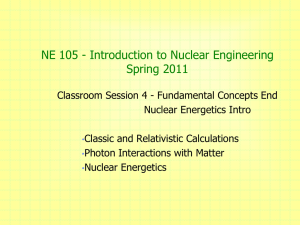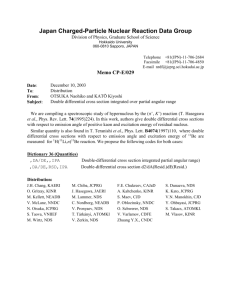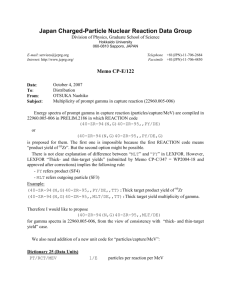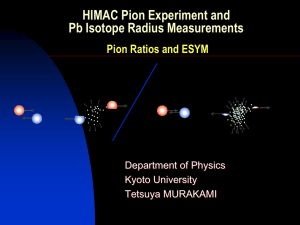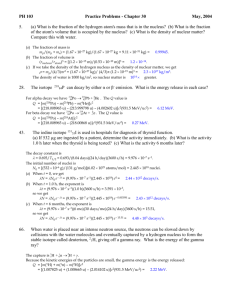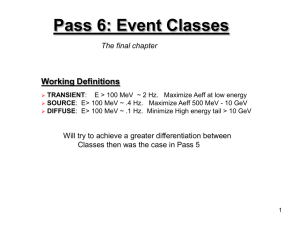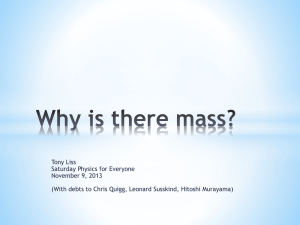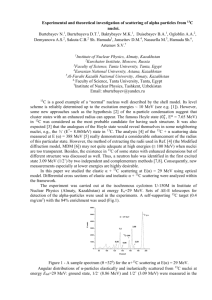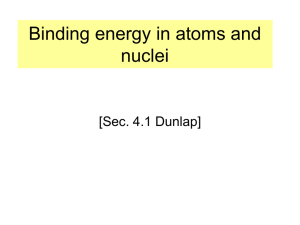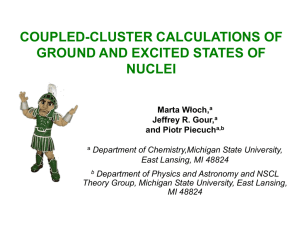Ch_19and21
advertisement
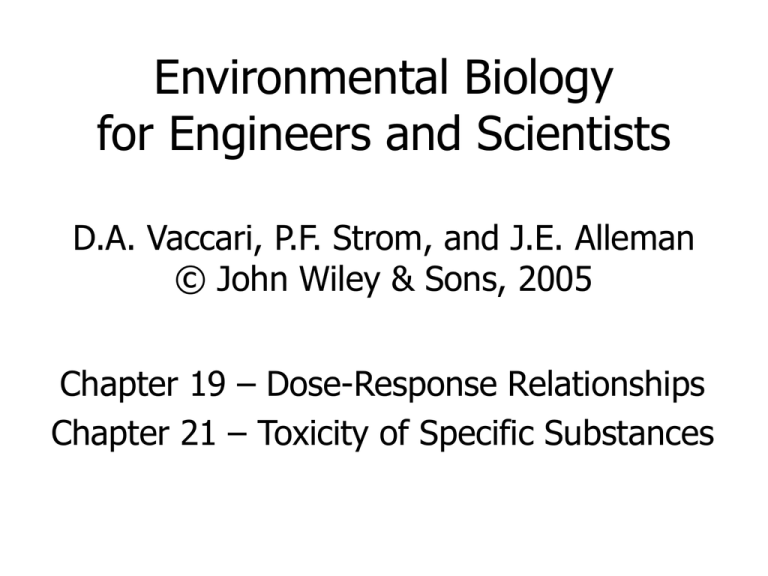
Environmental Biology for Engineers and Scientists D.A. Vaccari, P.F. Strom, and J.E. Alleman © John Wiley & Sons, 2005 Chapter 19 – Dose-Response Relationships Chapter 21 – Toxicity of Specific Substances Figure 19-1. Hypothetical dose-response relationship for (a) a substance required at low dosages, and (b) a nonessential substance. Death Irreversible damage a Reversible damage Homeostasis b C1 C2 Exposure concentration for fixed time Figure 19-2. Percent mortality (b) Normal tolerance distribution of mortality frequency. 100 80 Dose-response curve (a) 60 40 20 0 -20 0 1 120 100 2 3 Log dose Toxicity distribution 140 Slope of response (a) Sigmoidal logarithmicdose-response relationship. 120 (b) 80 60 40 20 0 -20 0 1 2 Log dose 3 Figure 19-3. Dose-response curve for a carcinogen and extrapolation to low dosages by linear and multistage models. 0.9 Fraction having tumors 0.8 Multistage model 0.7 0.6 0.5 0.4 0.3 Background response 0.2 0.1 Linear model 0.0 0 1 Linear Threshold 2 3 Dosage (ppm) 4 5 6 0.12 (a) Linear relationship for toxicity (the inverse of LD50); (b) Effect of mixture fraction (l) directly on LD50. (a) 0.08 0.06 0.04 0.02 0.00 0 0.2 0.4 l 0.6 0.8 1 0.6 0.8 1 100 LD50mix Figure 19-4. 1 / LD50mix 0.10 80 (b) 60 40 20 0 0 0.2 0.4 l Figure 19-5. A hypothetical time-toxicity curve. LD50 (mg/L) 1000 100 10 dt 1 0 1 10 Time (hrs) 100 1000 Figure 21-1. Structures of some organochlorine pesticides. CHLORINATED INSECTICIDES Cl H C Cl Cl C Cl Cl Cl Cl Cl Cl Cl Cl Dichloro-diphenyl-trichloroethane ( DDT) Cl Cl Cl Cl Cl CCl2 Cl Cl Cl Lindane ( a fungicide) Chlordane CCl2 CH2 Cl Dieldrin Cl O Figure 21-1. More structures of some organochlorine pesticides. CHLORINATED HERBICIDES Cl Cl O O CH2 CH2 COOH COOH Cl Cl Cl 2,4-dichlorophenoxyacetic acid ( 2,4-D) 2,4,5-trichlorophenoxyacetic acid ( 2,4,5-T) Figure 21-2. Structures of some unchlorinated pesticides. ORGANOPHOSPHATE PESTICIDES S O C2H5 P O O C2H5 NO2 Parathion S O CH3 P S O CH3 O CH H2C C O C2H5 C O C2H5 O Malathion OH O P OH O CH2 N CH2 C H Glyphosate - an herbicide OH Figure 21-2. More structures of some unchlorinated pesticides. CARBAMATE INSECTICIDES NITROGEN-BASED PESTICIDES O O C Cl NH CH3 N N CH3 H3C CH2 NH N NH CH CH3 Carbaryl ( Sevin) Atrazine ( a triazine used as an herbicide) Figure 21-3. Effect of thiophosphorus pesticides on ammonia oxidation by estuarine nitrifiers. [Originally from Jones, RD, Hood NA: The effects of organophosphorus pesticides on estuarine ammonia oxidizers. Can J Microbiol 26:1296-1299, 1980.] 80 Control 70 Methyl-Parathion Percent activity 60 50 Parathion 40 Guthion 30 20 Fonofos 10 0 5 7 9 11 t (days) 13 15 Figure 21-4. The Uranium-238 decay series. ATOMIC NUMBER 238 U-238 4.5e9 yr 4.2 MeV 234 U-234 2.5e5 yr 4.7-4.8 MeV 91 - (Pa) Protactinium Pa Pa-234m 1.2 months 2.3 MeV 90 - (Th) Thorium Th Th-234 24 days 0.2, 0.1 MeV 89 - (Ac) Actinium Ac 88 - (Ra) Radium Ra 87 - (Fr) Francium Fr 86 - (Rn) Radon Rn 85 - (At) Astatine At 84 - (Po) Polonium Po 83 - (Bi) Bismuth 82 - (Pb) Lead 92 - (U) Uranium 230 226 MASS NUMBER 222 218 214 210 206 Alpha Decay (helium nucleus ejected) Th-230 8.0e4 yr 4.6-4.7 MeV Beta Decay (electron ejected) Ra-226 1600 yr 4.8 MeV Rn-222 3.82 days 5.5 MeV Po-218 3.05 min 6.0 MeV Po-214 1.6e-4 sec 7.7 MeV Po-210 138 days 5.3 MeV Bi Bi-214 19.7 min 0.4-3.3 MeV Bi-210 5.0 days 1.2 MeV Pb Pb-214 26.8 min 0.7, 1.0 MeV Pb-210 22 yr <0.1 MeV Pb-206 Stable Figure 21-5. Relation between forward mutation rate per locus per rad and the DNA content per haploid genome. Line is regression through zero. Point for man estimated from DNA content. Redrawn from data of Abrahamson, S., Bener, M.A., Conger, A.D., and Wolff, S. (1973). Uniformity of radiation-induced mutation rates among different species. Nature 245, 460.] Log of specific locus mutations per locus per rad -6.0 Tomato Barley -6.5 Man -7.0 Mouse -7.5 -8.0 Fruit fly -8.5 Fungus Yeast -9.0 E. Coli -9.5 0.01 0.1 1 DNA per haploid genome 10 100

